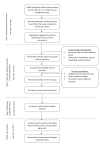Research prioritisation on prevention and management of preterm birth in low and middle-income countries (LMICs) with a special focus on Bangladesh using the Child Health and Nutrition Research Initiative (CHNRI) method
- PMID: 37651640
- PMCID: PMC10472017
- DOI: 10.7189/jogh.13.07004
Research prioritisation on prevention and management of preterm birth in low and middle-income countries (LMICs) with a special focus on Bangladesh using the Child Health and Nutrition Research Initiative (CHNRI) method
Abstract
Background: Fifteen million babies are born preterm globally each year, with 81% occurring in low- and middle-income countries (LMICs). Preterm birth complications are the leading cause of newborn deaths and significantly impact health, quality of life, and costs of health services. Improving outcomes for newborns and their families requires prioritising research for developing practical, scalable solutions, especially in low-resource settings such as Bangladesh. We aimed to identify research priorities related to preventing and managing preterm birth in LMICs for 2021-2030, with a special focus on Bangladesh.
Methods: We adopted the Child Health and Nutrition Research Initiative (CHNRI) method to set research priorities for preventing and managing preterm birth. Seventy-six experts submitted 490 research questions online, which we collated into 95 unique questions and sent for scoring to all experts. A hundred and nine experts scored the questions using five pre-selected criteria: answerability, effectiveness, deliverability, maximum potential for burden reduction, and effect on equity. We calculated weighted and unweighted research priority scores and average expert agreement to generate a list of top-ranked research questions for LMICs and Bangladesh.
Results: Health systems and policy research dominated the top 20 identified priorities for LMICs, such as understanding and improving uptake of the facility and community-based Kangaroo Mother Care (KMC), promoting breastfeeding, improving referral and transport networks, evaluating the impact of the use of skilled attendants, quality improvement activities, and exploring barriers to antenatal steroid use. Several of the top 20 questions also focused on screening high-risk women or the general population of women, understanding the causes of preterm birth, or managing preterm babies with illnesses (jaundice, sepsis and retinopathy of prematurity). There was a high overlap between research priorities in LMICs and Bangladesh.
Conclusions: This exercise, aimed at identifying priorities for preterm birth prevention and management research in LMICs, especially in Bangladesh, found research on improving the care of preterm babies to be more important in reducing the burden of preterm birth and accelerating the attainment of Sustainable Development Goal 3 target of newborn deaths, by 2030.
Copyright © 2023 by the Journal of Global Health. All rights reserved.
Conflict of interest statement
Disclosure of interest: The authors completed the ICMJE Disclosure of Interest Form (available upon request from the corresponding author) and disclose no relevant interests.
Figures
Similar articles
-
Setting research priorities to reduce global mortality from preterm birth and low birth weight by 2015.J Glob Health. 2012 Jun;2(1):010403. doi: 10.7189/jogh.02.010403. J Glob Health. 2012. PMID: 23198132 Free PMC article.
-
Research priorities to reduce the impact of COVID-19 in low- and middle-income countries.J Glob Health. 2022 Apr 15;12:09003. doi: 10.7189/jogh.12.09003. eCollection 2022. J Glob Health. 2022. PMID: 35475006 Free PMC article.
-
Setting a research agenda to advance maternal, newborn, and child health in Ethiopia: An adapted CHNRI prioritization exercise.J Glob Health. 2023 Feb 10;13:04010. doi: 10.7189/13.04010. J Glob Health. 2023. PMID: 37478357 Free PMC article.
-
Interventions to reduce preterm birth and stillbirth, and improve outcomes for babies born preterm in low- and middle-income countries: A systematic review.J Glob Health. 2021 Dec 30;11:04050. doi: 10.7189/jogh.11.04050. eCollection 2021. J Glob Health. 2021. PMID: 35003711 Free PMC article.
-
Evidence-based interventions to reduce mortality among preterm and low-birthweight neonates in low-income and middle-income countries: a systematic review and meta-analysis.BMJ Glob Health. 2021 Feb;6(2):e003618. doi: 10.1136/bmjgh-2020-003618. BMJ Glob Health. 2021. PMID: 33602687 Free PMC article.
Cited by
-
Global regional, and national burden of type 2 diabetes attributable to dietary factors from 1990 to 2021.Sci Rep. 2025 Apr 17;15(1):13278. doi: 10.1038/s41598-025-98022-y. Sci Rep. 2025. PMID: 40246938 Free PMC article.
-
Setting stakeholder-led research priorities for advancing Sexual and Reproductive Health and Rights in Bangladesh using CHNRI method: an icddr,b initiative.J Glob Health. 2025 Jul 11;15:04186. doi: 10.7189/jogh.15.04186. J Glob Health. 2025. PMID: 40643139 Free PMC article.
-
'Counselling is the only thing to do': healthcare providers' experience of Kangaroo Mother Care in Bangladesh - a qualitative study.BMJ Public Health. 2024 Nov 28;2(2):e001133. doi: 10.1136/bmjph-2024-001133. eCollection 2024 Dec. BMJ Public Health. 2024. PMID: 40018567 Free PMC article.
References
-
- Perin J, Mulick A, Yeung D, Villavicencio F, Lopez G, Strong KL, et al. Global, regional, and national causes of under-5 mortality in 2000–19: an updated systematic analysis with implications for the Sustainable Development Goals. Lancet Child Adolesc Health. 2022;6:106-15. 10.1016/S2352-4642(21)00311-4 - DOI - PMC - PubMed

